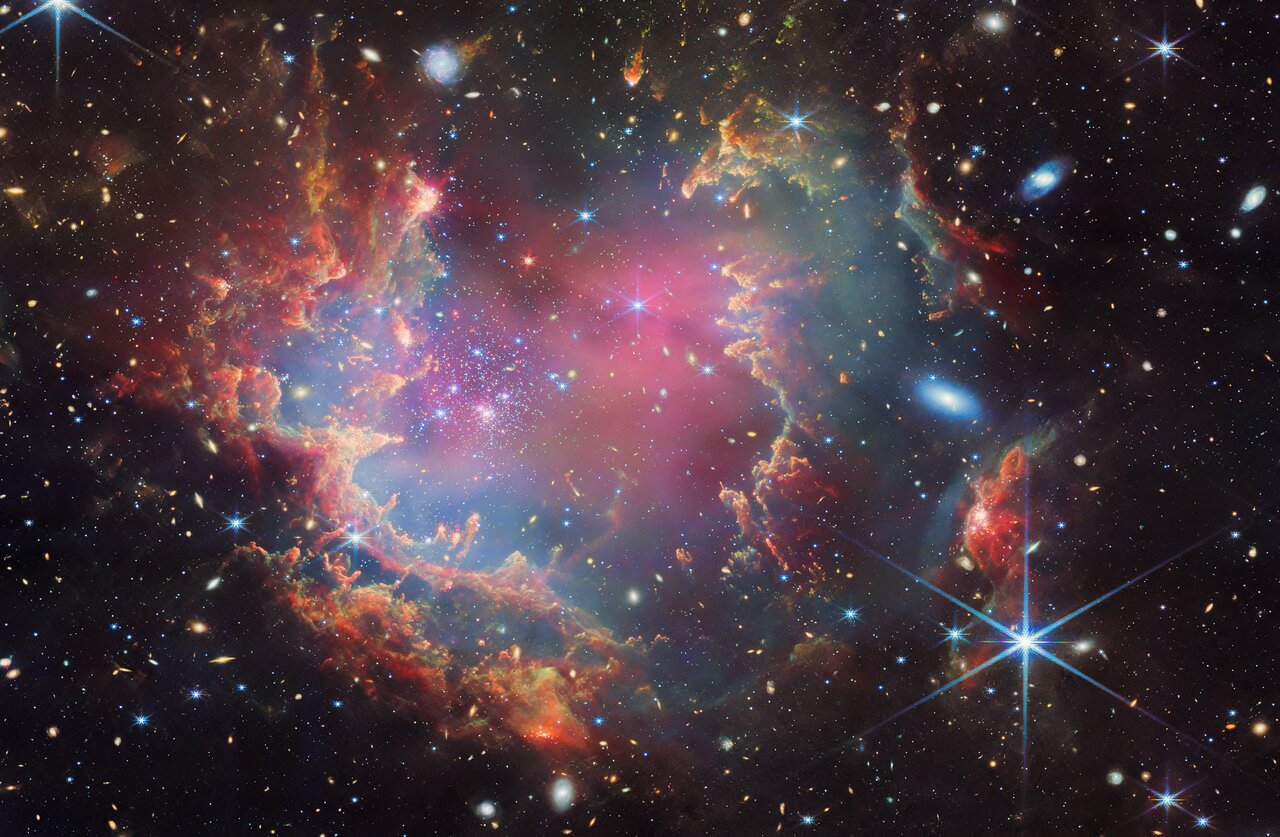At this level, astronomers are used to the James Webb House Telescope pushing the boundaries of astronomy — so it’s little shock that the $10 billion telescope has surpassed itself once more.
The James Webb House Telescope (JWST) — with somewhat assist from the Hubble House Telescope — might have discovered a household of so-called “failed star” brown dwarfs within the Milky Method’s satellite tv for pc galaxy, the Small Magellanic Cloud (SMC). If that is so, it will likely be the primary time astronomers have noticed such our bodies past the boundaries of our personal galaxy.
The potential brown dwarfs are situated on the fringe of the SMC, a dwarf galaxy near the Milky Method, in a younger star cluster referred to as NGC 602. NGC 602 is round 200,000 light-years from Earth. This star cluster is well-studied by astronomers as a result of its thick clouds of mud and fuel, the constructing blocks of stellar our bodies, are believed to be websites of intense star formation. Star formation on this area of the SMC is additional evidenced by an related patch of ionized hydrogen, referred to as N90. Atomic hydrogen is created when intense ultraviolet mild from younger stars strips electrons away from hydrogen atoms.
Additionally, as a result of it has an under-abundance of components heavier than hydrogen and helium (astronomers name these heavier components “metals”), areas like NGC 602 and the broader SMC are good proxies for “metal-poor” galaxies discovered within the early universe.
“By finding out the younger metal-poor brown dwarfs newly found in NGC602, we’re getting nearer to unlocking the secrets and techniques of how stars and planets fashioned within the harsh situations of the early universe,” staff member and College of Arizona scientist Elena Sabbi mentioned in an announcement.
The identical thick lanes of fuel and mud make areas like this fascinating to review. Nevertheless, those self same lanes pose a problem for astronomers as a result of they soak up seen mild.
Lengthy-wavelength, low-frequency infrared mild can slip by means of these clouds with out being absorbed, and that’s the wavelength of sunshine the JWST research the cosmos in. This makes the JWST’s Close to-Infrared Digital camera (NIRCam) and Mid-Infrared Instrument (MIRI) ultimate for finding out the SMC and NGC 602. It’s little surprise the highly effective area telescope has as soon as once more damaged new floor with the potential first detection of extragalactic brown dwarfs.
Brown dwarfs fail…
Brown dwarfs are given their barely unfair nickname of failed stars as a result of they type like stars from a collapsing cloud of overly dense fuel and mud however solely attain plenty between 13 and 75 occasions that of Jupiter (0.13 to 0.75 occasions the mass of the solar). This implies they cannot generate sufficient strain and warmth to set off the fusion of hydrogen to helium of their cores, the method that defines a fundamental sequence star.
Brown dwarfs do not simply differ from planets by way of how they type. Not like most planets, these objects additionally wander the cosmos untethered to father or mother stars. They do share some traits with fuel big planets such because the composition of their atmospheres and the storms that rage throughout them.
Up to now, astronomers have detected round 3,000 brown dwarfs, however all of those have been inside the boundary of the Milky Method. These extragalactic brown dwarfs appear to verify theories of how budding stars fail.
“Our outcomes match very nicely with the speculation that the mass distribution of our bodies beneath the hydrogen burning restrict is just a continuation of the stellar distribution,” staff member ESA scientist Peter Zeidler mentioned in the identical assertion. “It appears they type in the identical method; they simply do not accrete sufficient mass to grow to be a fully-fledged star.”
…However the JWST succeeds
Along with presenting groundbreaking science, the JWST/NIRCam/MIRI information collected as a part of the JWST GO program quantity 2662 has additionally introduced us a staggeringly stunning picture of NGC 602.

“This discovery highlights the ability of utilizing each Hubble and the JWST to review younger stellar clusters,” staff member Antonella Nota, govt director of the Worldwide House Science Institute in Switzerland and the previous JWST Challenge Scientist for the ESA, mentioned within the assertion. “Hubble confirmed that NGC602 harbors very younger low-mass stars, however solely with the JWST, can we lastly see the extent and the importance of the substellar mass formation on this cluster.
“Hubble and the JWST are an amazingly highly effective telescope duo!”
The photographs of NGC 602 captured in April 2023 function its incumbent star clusters and surrounding mud lanes and fuel clouds. They signify a brand new period of finding out native metal-poor galaxies intimately, not potential for the universe’s earliest hydrogen- and helium-dominated galaxies situated billions of light-years away.
“Solely with the unbelievable sensitivity and spatial decision within the right wavelength regime is it potential to detect these objects at such nice distances,” Zeidler concluded. “This has by no means been potential earlier than and likewise will stay not possible from the bottom for the foreseeable future.”
The staff’s analysis is revealed on Oct. 23 in The Astrophysical Journal.





